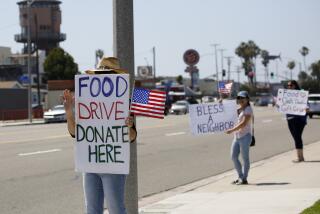Donating Less Taxing Than Garage Sale
Holding a garage sale is a traditional springtime way of uncluttering a home and making a little pocket money. But if you itemize your taxes, you’re probably better off ditching the cardboard signs and donating your household goods to charity.
The same law that makes it a bad financial deal to donate certain items, such as cars, makes it a much better deal to donate your old clothes, knickknacks and china. To understand why, you have to understand how the tax law works.
The Internal Revenue Service allows taxpayers who itemize to write off the fair market value of donated goods. Fair market value means the price a willing buyer would pay a willing seller if neither were under pressure to sell or buy.
That makes donating a car a bum deal in strictly financial terms, because the donor cannot deduct more than the car would bring on the open market. The value of the deduction is further limited by the taxpayer’s bracket; a car that could be sold for $1,200 brings a tax break worth about $405 for someone in the 28% federal and 8% state brackets. The car owner would be much better off financially just selling the car and pocketing the money.
When it comes to household goods, however, the market is much less efficient.
In most garage sales, the seller is usually much more willing than the buyer. In particular, people holding moving sales are often desperate to get rid of their unwanted stuff and usually end up discarding or donating anything that doesn’t sell during their four-hour sale. That throws the idea of fair market value out of whack and leads to prices far lower than would be charged in a consignment store or thrift shop.
Hardcover books are a great example. Woe to the garage saler who charges more than $1, even for a current bestseller; most sale-goers would consider a two-digit price unthinkable, even for expensive coffee-table books.
Yet hardcovers typically start at $5 in most secondhand shops; art and coffee-table books can be $100 or more in used-book stores, depending on their condition and rarity. Those sellers can wait for buyers willing to meet their price, since they’re not trying to close up shop by noon.
The IRS allows people who donate household items to use the higher values found in secondhand stores, rather than the fire-sale prices of garage sales.
A $5 book would reap a $1.69 tax break for the donor in the 28% federal and 8% state brackets, putting the donor ahead of the garage saler who received a tattered dollar bill.
The tax break grows the higher your tax bracket. To someone in the 39.6% federal and 9.3% state stratosphere, the $5 book brings a $2.26 reduction in taxes. Perhaps now you understand why garage sales are rare in Beverly Hills.
Determining fair market value for a pile of books, clothes, kitchen gadgets and furniture is no easy task, however. The IRS won’t allow you to use a formula, such as 25% or 50% of the purchase price, because that doesn’t reflect market realities. Your ‘70s-era platforms may be worth nearly what you paid for them when they’re offered in some Melrose Avenue resale store, while your holey, sweat-stained Duran Duran T-shirt may have value only as a dust rag.
To arrive at a price, you can do extensive research at local thrift shops, consignment stores and flea markets. For some items, you can check the classifieds. Or you can spend about $18 for a copy of “Cash for Your Used Clothing,” a guide compiled each year by certified public accountant William R. Lewis. The booklet is available by mail order at (800) 875-5927 or https://www.taxsave.com.
The booklet lists hundreds of household items, from dishes to old computers, assigning values to each depending on age and condition. Like any good accountant, Lewis encourages taxpayers to be reasonable in valuing items.
Donations do involve some paperwork. Donors should make a list of each item, its condition and its fair market value. Lewis recommends photographing the items as well. Both the list and the photograph should be kept with other supporting documents for the tax return in case of audit; they should not be sent to the IRS.
It’s smart to get a receipt for any donation, but it’s required for donations worth more than $250. If the total deduction for “noncash contributions” is more than $500, the taxpayer must also fill out Section A of Form 8283. If the donation is worth more than $5,000, the taxpayer needs to get an independent appraisal and fill out Section B of Form 8283. For more information, see IRS Publication 526, “Charitable Contributions.”
Of course, donating used goods means a bit of deferred gratification. Instead of an apron full of quarters and crumpled bills from a garage sale, your payoff is a lower tax bill, a larger refund or--if you adjust your withholding to reflect the donation--a slightly larger paycheck each week. Then again, you don’t have to haggle with a stranger over the price of your discards. That should be worth something.
Liz Pulliam Weston is a personal-finance writer for The Times and a graduate of the personal financial planning certificate program at UC Irvine. Questions can be sent to her at [email protected] or mailed to her in care of Money Talk, Business Section, Los Angeles Times, Times Mirror Square, Los Angeles, CA 90053. She regrets that she cannot respond personally to queries. For past Money Talk questions and answers, visit The Times’ Web site at http://arstechnica.netblogpro.com/moneytalk.
More to Read
Inside the business of entertainment
The Wide Shot brings you news, analysis and insights on everything from streaming wars to production — and what it all means for the future.
You may occasionally receive promotional content from the Los Angeles Times.










